October 5, 2025
Equities again sit at or near all-time highs on the major indices. A supportive Fed and continued interest in AI concepts have boosted equity prices and Technology shares in the near-term. However, market breadth has narrowed at the stock level despite the advance (chart below). The mega cap. leadership embedded within the AI trade has been pulling the rest of the US equity market higher rather than enabling organic growth at the stock level across a broad array of industries. That is in large part to be expected, but it does setup a question as to what scenarios investors will discount going forward. We think the performance of Discretionary stocks will be a key tell into the end of the year. If we see investors moving towards discretionary stocks, we should take that as a bullish sign on the health of the equity trend.
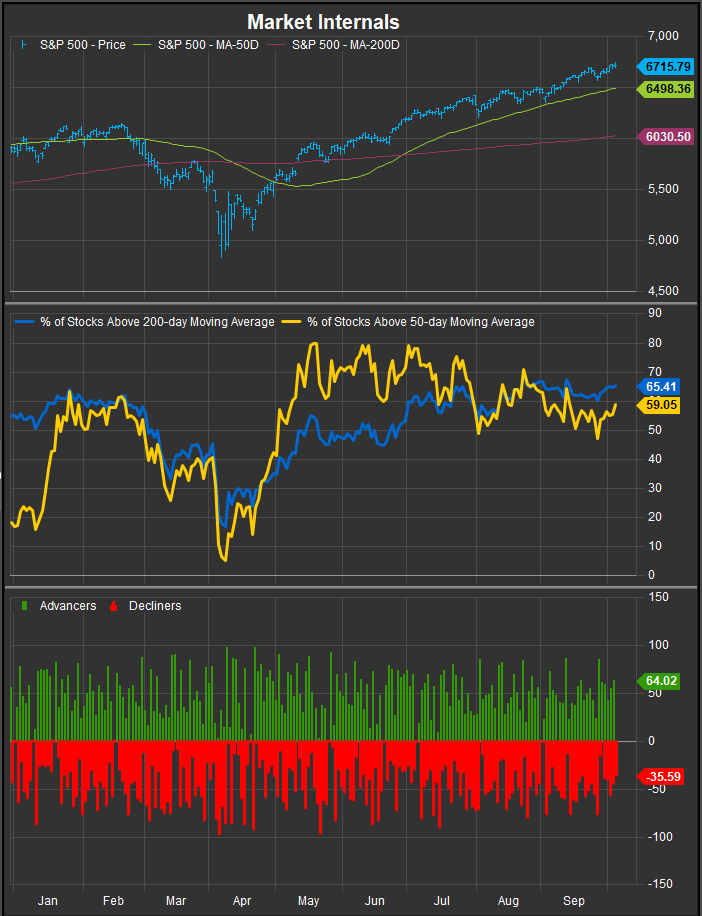
The U.S. consumer landscape has entered a more nuanced phase in late 2025, with policy, credit, and sentiment factors pulling in opposite directions. On the positive side, the Federal Reserve’s shift toward a more dovish stance is beginning to ease financial conditions. After the September 17 rate cut, the first in over a year, markets are now pricing the potential for two additional cuts by year-end. This pivot has supported equity valuations and consumer confidence by lowering the perceived cost of money and signaling that the Fed is prioritizing growth stabilization over inflation vigilance. Treasury yields have moderated at the margin, and broader liquidity conditions have improved, helping households refinance and easing pressure on credit spreads.
Discretionary sector breadth (XLY, chart below) has been weaker than the broad market in the near-term.
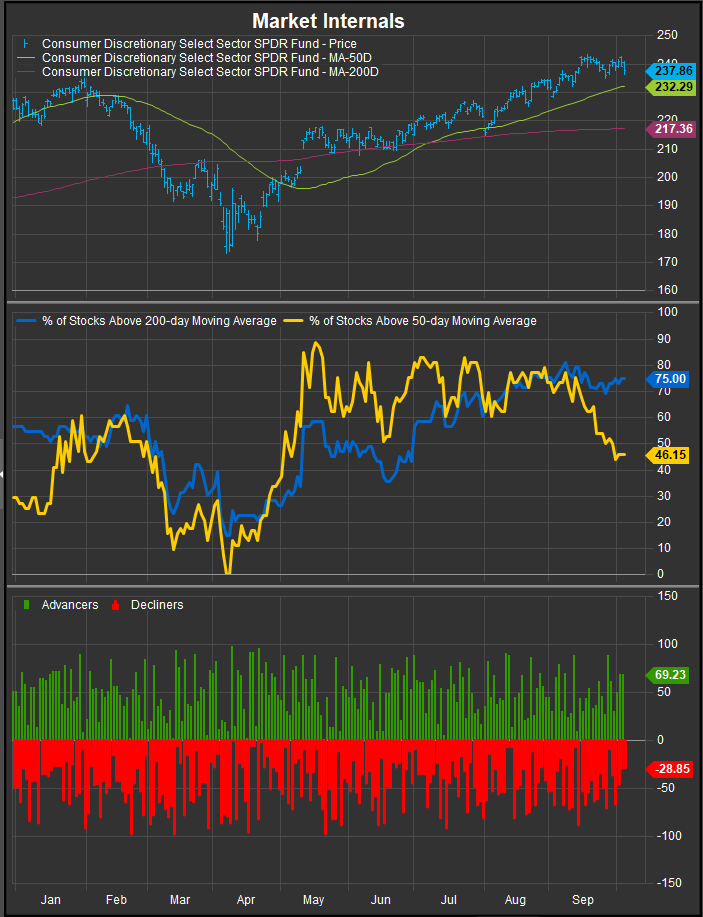
Mortgage rates have also retreated from their 2023 highs, with the 30-year fixed mortgage averaging roughly 6.3% in early October, compared with the 7–8% levels that froze housing activity last year. Though affordability remains strained, each 50-basis-point decline improves monthly payment capacity and encourages a modest rebound in existing-home sales and renovation activity. Even for households not directly tied to the housing market, lower mortgage rates tend to boost sentiment through wealth and confidence effects. Housing-linked consumer categories, such as home improvement, furnishings, and appliances, are expected to stabilize as this dynamic plays out over the next several quarters.
Stocks like DHI (chart below) have firmed on expectations of continued gains in affordability.
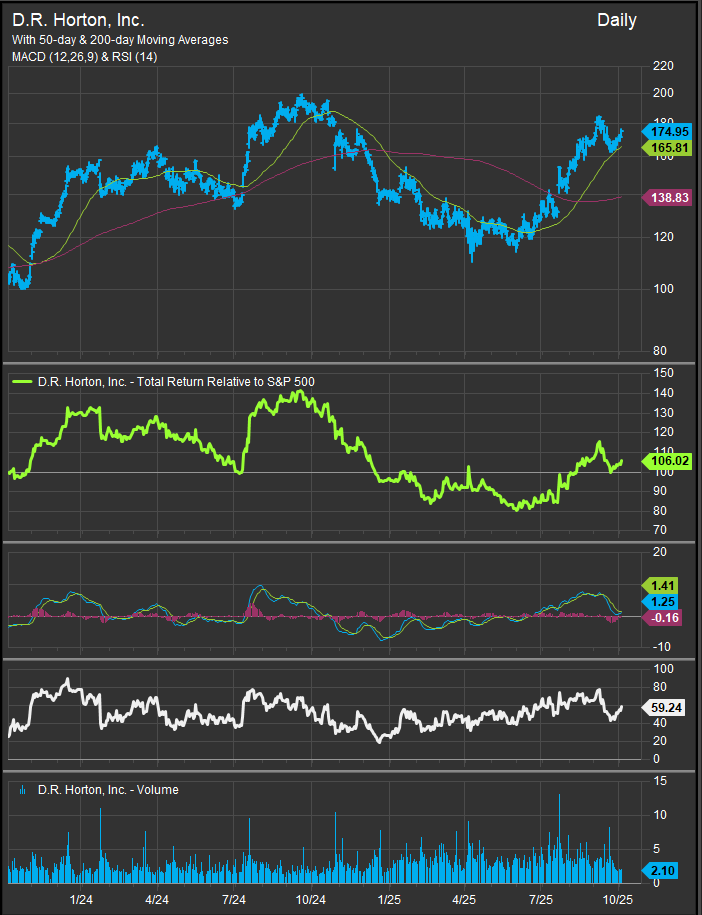
Spending patterns, meanwhile, continue to reveal the evolving psychology of a value-conscious consumer. Across income segments, households are increasingly substituting smaller-ticket discretionary purchases for larger outlays and prioritizing experiences that offer high perceived value. This “substitution effect” is visible in the strength of experiential categories—particularly cruise travel, which continues to set record bookings into 2026—as consumers seek affordable escapes over durable goods or fashion splurges. Restaurants, off-price retailers, and mass-market brands have also benefitted from this behavioral shift, while premium discretionary and luxury goods have seen slower volume growth.
Nike (chart below) has been a victim of the value/budget conscious consumer.

Still, significant headwinds remain. Household debt reached $18.4 trillion in the second quarter, with delinquency rates continuing to edge higher across credit cards, auto loans, and newly reinstated student debt. The resumption of student-loan payments has hit younger consumers hardest, while lower-income households face tighter budgets due to elevated revolving-credit balances and higher minimum payments. Surveys from Deloitte and McKinsey confirm that trading-down and deal-seeking behavior remain entrenched, with consumers planning to delay or downgrade purchases heading into the holiday season. PwC’s September survey noted a projected 5% decline in holiday spending per shopper, the sharpest drop since 2020, led by weaker appetite for apparel, electronics, and dining out.
These micro pressures have intersected with macro market shifts to drive underperformance in the consumer complex over the past month. Despite a supportive monetary backdrop, the sector has lagged broader indices as investors rotated into higher-growth and defensive areas like technology and utilities. The S&P 500 Consumer Discretionary sector is down roughly 4.5% over the past month, reflecting both cyclical sensitivity to rates and a cluster of company-specific disappointments. Even as long-term yields eased slightly, intermittent bouts of bond-market volatility and mixed messaging from Fed officials reignited fears of a slower-than-expected easing cycle, compressing valuation multiples in rate-sensitive segments such as autos, home improvement, and internet retail.
The XLY (chart below) has lagged in the near-term.
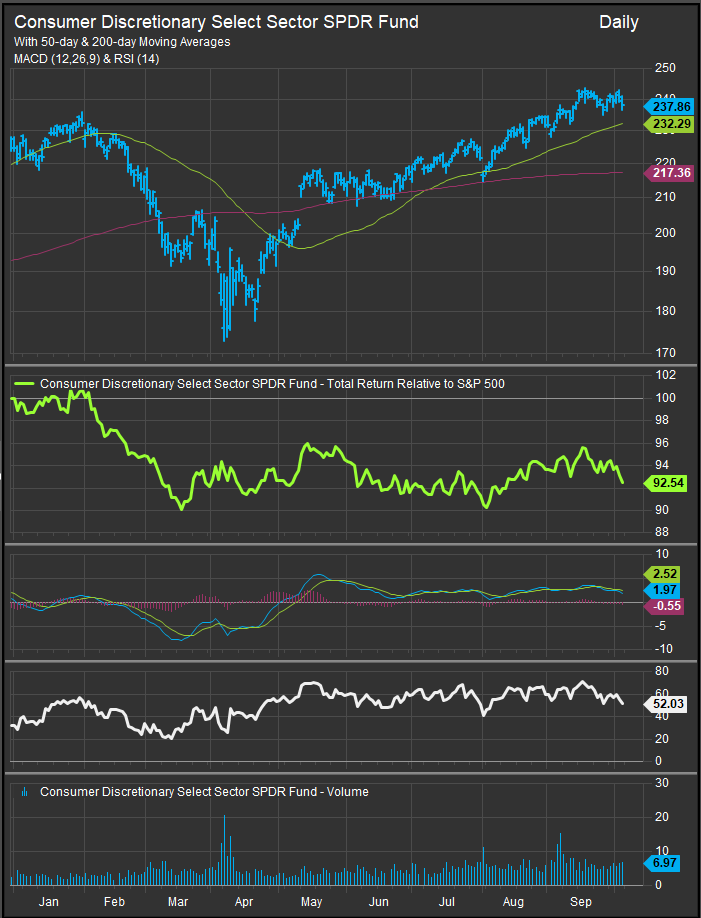
Consumer sentiment data have also softened modestly, with Conference Board and University of Michigan indices showing declines in expectations components. Wage growth has cooled, and the savings rate remains below its pre-pandemic average, implying less cushion against macro shocks. These dynamics have led investors to take profits in consumer names that ran strongly earlier in 2025, especially those priced for sustained demand momentum. Cost and margin guidance has turned more cautious as well, with management teams citing persistent input inflation, higher labor costs, and a normalization in pricing power following two years of aggressive price pass-throughs. The result has been downward earnings revisions and valuation compression across key discretionary subsectors.
At the company level, performance dispersion remains wide. Top performers year-to-date within the S&P 500 consumer discretionary cohort include Tapestry (+145%), Royal Caribbean (+122%), DoorDash (+87%), Tesla (+80%), and Ralph Lauren (+79%), reflecting strong demand for experiential travel and select digitally enabled retail platforms. In contrast, several high-profile laggards have weighed on the group. Macau-exposed casino operators such as Wynn Resorts and Las Vegas Sands have fallen sharply on event-specific risks, while Nike remains volatile, only recently recovering from year-to-date losses tied to China softness and tariff headwinds. Within staples, performance has been muted overall, although niche outperformers such as Celsius Holdings, Philip Morris, and Casey’s General Stores have bucked the trend.
Tapestry (chart below) has been a bullish standout in this cycle.
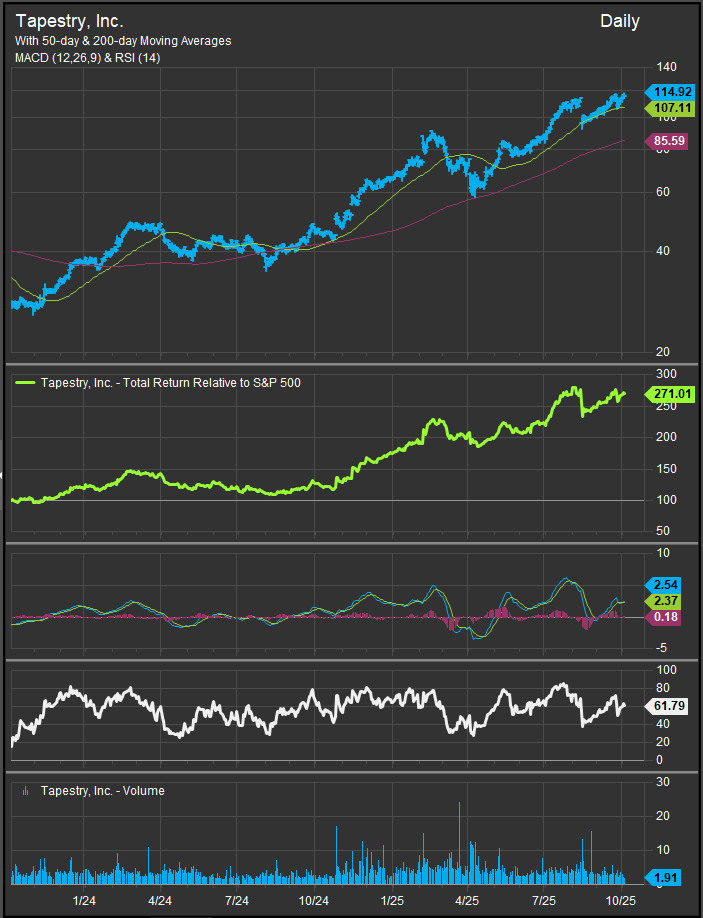
In summary, the U.S. consumer sector is navigating a delicate equilibrium. Easing monetary policy, lower mortgage rates, and resilient travel demand are meaningful supports, but they are being offset by credit deterioration, stretched household budgets, and fading pricing power. As holiday spending and Q3 earnings unfold, investor attention will center on how effectively companies balance margin protection with affordability and whether the Fed can deliver sustained easing without reigniting inflationary pressure. For now, the bias within the sector remains toward value-driven, experience-oriented names and away from premium discretionary categories that rely on a robust, credit-fueled consumer. Look for Consumer sector performance to be a key tell on the health of the overall trend for equities. If investors begin discounting a more bullish scenario for the consumer, this bull should be able to run.
Sources
- Bloomberg L.P. (2025). Sector & Industry Performance Dashboard: S&P 500 Consumer Discretionary and Consumer Staples Index Returns. Retrieved October 3, 2025, from https://www.bloomberg.com/markets/sectors
- Freddie Mac Primary Mortgage Market Survey (PMMS). (2025, October 2). 30-Year Fixed Mortgage Rate Averages 6.34%. Retrieved from https://www.freddiemac.com/pmms
- Federal Reserve Board of Governors. (2025, September). FOMC Statement and Economic Projections (September Meeting). Retrieved from https://www.federalreserve.gov
- Federal Reserve Bank of New York. (2025, August). Quarterly Report on Household Debt and Credit, Q2 2025. Retrieved from https://www.newyorkfed.org/microeconomics/hhdc.html
- Deloitte. (2025, September). Global Consumer Tracker – U.S. Insights on Spending Behavior. Retrieved from https://www.deloitte.com/consumer-tracker
- McKinsey & Company. (2025, August). Consumer Sentiment Tracker: U.S. Household Spending and Value Orientation. Retrieved from https://www.mckinsey.com/industries/consumer-packaged-goods
- PwC. (2025, September). Holiday Outlook 2025: U.S. Consumers Expect to Spend Less This Season. Retrieved from https://www.pwc.com/holidayoutlook
- The Conference Board. (2025, September). Consumer Confidence Index® Summary Results. Retrieved from https://www.conference-board.org/topics/consumer-confidence
- University of Michigan. (2025, September). Survey of Consumers: Expectations Index. Retrieved from https://data.sca.isr.umich.edu/
- Barchart.com. (2025, October). S&P 500 Consumer Discretionary Index Constituents – YTD Leaders and Laggards. Retrieved from https://www.barchart.com/stocks/indices/sp-sector/consumer-discretionary
Data sourced from FactSet Research Systems Inc.
